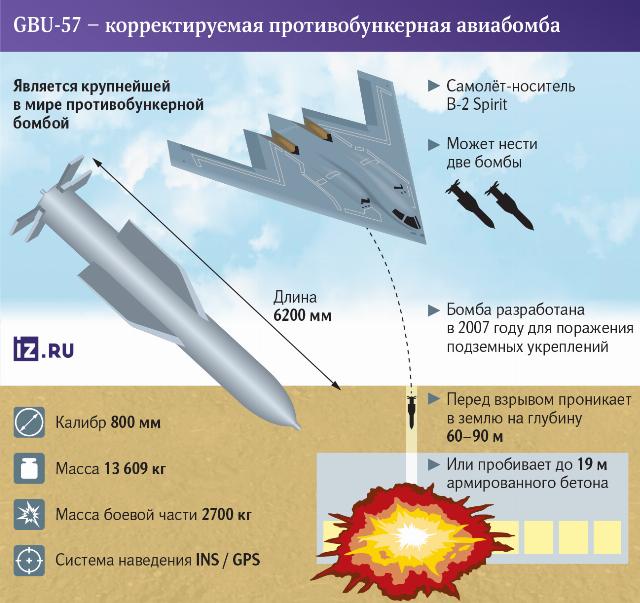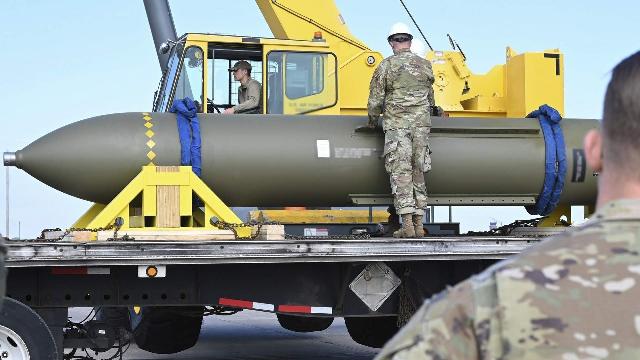Iran claims that it proved powerless against nuclear facilities hidden deep under the rocks.
On June 23, the Israeli Air Force continued to strike at Iran's nuclear facilities. But the resonance from the events that happened a day earlier does not subside — the United States used, among other things, the largest non—nuclear bombs in the world, GBU-57, in attacks on the centers in Fordo, Natanz and Isfahan. At the same time, the result of the strikes is unclear — the Americans claimed major damage to underground factories, the Iranians say that they cannot be called critical. Izvestia investigated how effective such super bombs are and what weapons Russia and other countries of the world have for destroying underground shelters.
Consequences of strikes on Iranian nuclear facilities
On the night of June 22, the United States bombed the Fordo uranium enrichment plant, as well as the centers in Natanz and Isfahan. B-2 stealth bombers were used, which used GBU-57 bunker buster bombs weighing 13 tons each. According to the Pentagon, the planes took off from Whiteman Air Base, located on the US mainland. They made an 18-hour flight, during which they refueled several times in the air.
The damage estimates from the attacks of the opponents are the opposite. "Enormous damage was caused to all nuclear facilities in Iran, which is confirmed by satellite images. Annihilation is an appropriate term," US President Donald Trump wrote on the Truth Social network.
Iran claimed that the damage was less than it could have been: an evacuation was carried out in advance in Tehran.
IAEA Director General Rafael Grossi said that the agency had recorded destruction at three Iranian nuclear facilities. According to him, the extent of damage inside the uranium enrichment facilities at Fordo cannot yet be determined due to the fact that they are underground. Iranian regulatory authorities have informed the IAEA that there has been no increase in radiation levels beyond the three attacked sites.
It is difficult for the parties to the conflict to take their word for it, military experts interviewed by Izvestia are sure.
"Now there are satellite photographs of Iranian nuclear facilities after the strike," Dmitry Kornev, editor of the Military Russia project, told Izvestia. — They show two groups of bomb craters. If we superimpose the intended layout of the premises on them, then we can assume that they really hit the object in Fordo. Whether the object can work after that or not is a very difficult question. Iran says that the facility was not damaged, they took out all the materials needed to create nuclear weapons. But there are not so many materials, according to Western estimates — 400 kilograms. They can be taken out by one car. The problem is that the technical equipment for nuclear fuel enrichment can hardly be moved quickly.
The Iranian nuclear facility at Fordo is located under a mountain, in the thickness of rocky soils, and its exact depth is unknown to us, but it is claimed to be up to 80-100 meters, said military expert Yuri Lyamin.
— Now it is definitely impossible to say that the bombs penetrated to the required depth and destroyed the object, — he noted. — These ammunition (GBU-57. They were developed to destroy bunkers in the ground in the DPRK and Iran, but there was no experience of their combat use. Their effectiveness can be influenced by many components, primarily the characteristics of rocks. Fordo is a very difficult target. Do not forget that underground rooms can be made in such a way as to minimize damage. For example, it can be equipped with explosion-proof doors, traps for blast waves. They will not allow the energy from the explosion to spread throughout the underground complex.
It is critical for Iran that the salvaged materials are also under threat of destruction, Dmitry Kornev believes.
"Iran may place them in secret warehouses, but this does not guarantee their safety," he said. — Israeli intelligence is working quite well in Iran. It is highly likely that the equipment will be found and, most likely, destroyed.
What is the GBU-57 bomb?
Of particular interest is the ammunition used by the United States to attack underground facilities. GBU-57 is the world's largest non—nuclear aerial bomb at the moment.
"The bomb is correctable, it does not have an engine, but it has short aerodynamic wings on the surface that allow it to make a gliding flight,— Dmitry Kornev told Izvestia. — In addition, it is equipped with lattice stabilizers that allow you to control its fall. It is equipped with a satellite navigation system, which ensures a sufficiently high accuracy of hitting the specified coordinates. Most likely, the deviation from the aiming point can range from 0 to 3-5 meters. The peculiarity of the bomb is that it penetrates the ground with its own mass and speed.
— Reinforced concrete — up to a depth of 19 meters. Ordinary soil is up to a depth of 60 meters," the expert noted. — And the most unusual feature of these bombs is that they can be used in series. That is, the first bomb pierces as much as it can, explodes. The second bomb hits the same passage, reaches the bottom, pierces as much as it can, and explodes too. And so it is several times.
According to open sources, the bomb has a smart fuse that not only explodes when the bomb stops moving, but is activated if it enters an open space, that is, an underground room.
— No one in the world has such bombs, — Dmitry Kornev noted. — For example, we have a BETAB-500SH (assault) bomb, equipped with an engine. It also penetrates not only concrete, but also the ground. But its caliber is smaller — only 500 kilograms.
There are no such monstrous bombs in other countries, Yuri Lyamin noted.
— In the USSR, the most powerful bombs were high—explosive bombs - FAB-5000 and FAB-9000, — the expert noted. — But they were not "sharpened" to work on underground bunkers, although, of course, due to the force of the explosion they could damage them. There is currently no carrier for the FAB-9000. In the USSR, Tu-16 bombers, which have already been decommissioned, were used as a carrier. The FAB-3000, the heaviest of their serial bombs, is now being mass—produced.
The expert noted that Daggers and missiles of the Oreshnik complex may be suitable for work on underground facilities.
"These missiles can destroy buried rooms due to their speed and penetrating warhead,— he noted. — Especially, of course, "Hazel". But all their characteristics are classified.
We do not know exactly the characteristics, but there is an assumption that the "Hazel" is just a penetrating ammunition that can penetrate the thickness of the earth's rock and hit protected objects, Dmitry Kornev believes.
— The second such missile system is the Kinzhal hypersonic complex. We have seen the use of the "Dagger" against quite seriously protected warehouses and headquarters. It penetrates several meters of concrete precisely and, in fact, it was created precisely as a concrete-cutting system. The German Taurus cruise missile can also work against buried concrete objects, but, of course, its capabilities are not as impressive as those of the American bomb, the expert said.
Russian guided bombs weighing 1.5 and 3 tons with a guided correction module (UMPC) are serious weapons. The KAB-1500 and KAB-3000 are correctable aerial bombs capable of hitting targets with high accuracy. FAB-1500 and FAB-3000 are high—explosive aerial bombs that effectively hit protected fortifications. This is a large enough mass to seriously penetrate the thick layers of concrete and soil that protect the facility, Dmitry Kornev summarized.
China has similar developments. In 2019, Chinese media published images from the tests of a bomb designed to destroy bunkers and buried fortifications. On the Web, this aviation munition was called the Chinese version of the tsar bomba ("superbomb"). Product specifications were not disclosed.
The mutual blows continue
On June 23, attacks on Iranian nuclear facilities continued. In particular, on Monday, Israel attacked the facility in Fordo again, the Mehr news agency reported.
The IDF press service reported that more than 50 Israeli Air Force fighter jets attacked military and production facilities in Tehran. "The Israeli Air Force, under the leadership of the IDF intelligence directorate, attacked military command posts belonging to the Iranian regime," the report said. It is specified that missile and radar production facilities and their storage infrastructure were hit.
"We welcome and are glad that we have the support of the United States in the difficult task that we face in terms of eliminating the threat posed by Iran," IDF spokeswoman Anna Ukolova told Izvestia.
 |
| GBU-57. |
| Source: iz.ru |
Iran also attacked targets in Israel, using several types of ballistic missiles. According to the Fars news agency, citing sources, Kheibar Shekan, Emad, Qadr and Fattah-1 missiles were used in the attacks on June 23.
Roman Kretsul
Bogdan Stepovoy
Albert Kalashyan

